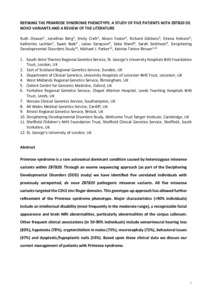Cleaver, R;
Berg, J;
Craft, E;
Foster, A;
Gibbons, RJ;
Hobson, E;
Lachlan, K;
Naik, S;
Sampson, JR;
Sharif, S;
et al.
Cleaver, R; Berg, J; Craft, E; Foster, A; Gibbons, RJ; Hobson, E; Lachlan, K; Naik, S; Sampson, JR; Sharif, S; Smithson, S; Deciphering Developmental Disorders Study; Parker, MJ; Tatton-Brown, K
(2001)
Refining the Primrose syndrome phenotype: A study of five patients with ZBTB20 de novo variants and a review of the literature.
Am J Med Genet A, 179 (3).
pp. 344-349.
ISSN 1552-4833
https://doi.org/10.1002/ajmg.a.61024
SGUL Authors: Tatton-Brown, Katrina Louise
![[img]](https://openaccess.sgul.ac.uk/114082/1.hassmallThumbnailVersion/Refining%20the%20Primrose%20symdrone%20phenotype.pdf)  Preview |
|
PDF
Accepted Version
Available under License ["licenses_description_publisher" not defined].
Download (209kB)
| Preview
|
Abstract
Primrose syndrome is a rare autosomal dominant condition caused by heterozygous missense variants within ZBTB20. Through an exome sequencing approach (as part of the Deciphering Developmental Disorders [DDD] study) we have identified five unrelated individuals with previously unreported, de novo ZBTB20 pathogenic missense variants. All five missense variants targeted the C2H2 zinc finger domains. This genotype-up approach has allowed further refinement of the Primrose syndrome phenotype. Major characteristics (>90% individuals) include an intellectual disability (most frequently in the moderate range), a recognizable facial appearance and brain MRI abnormalities, particularly abnormalities of the corpus callosum. Other frequent clinical associations (in 50-90% individuals) include sensorineural hearing loss (83%), hypotonia (78%), cryptorchidism in males (75%), macrocephaly (72%), behavioral issues (56%), and dysplastic/hypoplastic nails (57%). Based upon these clinical data we discuss our current management of patients with Primrose syndrome.
| Item Type: |
Article
|
| Additional Information: |
This is the peer reviewed version of the following article: Cleaver, R, Berg, J, Craft, E, et al. Refining the Primrose syndrome phenotype: A study of five patients with ZBTB20 de novo variants and a review of the literature. Am J Med Genet Part A. 2019; 179A: 344– 349, which has been published in final form at https://doi.org/10.1002/ajmg.a.61024. This article may be used for non-commercial purposes in accordance with Wiley Terms and Conditions for Use of Self-Archived Versions. This article may not be enhanced, enriched or otherwise transformed into a derivative work, without express permission from Wiley or by statutory rights under applicable legislation. Copyright notices must not be removed, obscured or modified. The article must be linked to Wiley’s version of record on Wiley Online Library and any embedding, framing or otherwise making available the article or pages thereof by third parties from platforms, services and websites other than Wiley Online Library must be prohibited. |
| Keywords: |
DDD study, Primrose syndrome, ZBTB20, exome sequencing, intellectual disability, Abnormalities, Multiple, Calcinosis, Child, Child, Preschool, Ear Diseases, Facies, Female, Genetic Association Studies, Genetic Loci, Genetic Predisposition to Disease, Genetic Variation, Genotype, Humans, Intellectual Disability, Magnetic Resonance Imaging, Male, Muscular Atrophy, Mutation, Nerve Tissue Proteins, Phenotype, Transcription Factors, Deciphering Developmental Disorders Study, Humans, Ear Diseases, Muscular Atrophy, Abnormalities, Multiple, Calcinosis, Genetic Predisposition to Disease, Facies, Nerve Tissue Proteins, Transcription Factors, Magnetic Resonance Imaging, Genotype, Phenotype, Mutation, Child, Child, Preschool, Female, Male, Genetic Variation, Genetic Loci, Genetic Association Studies, Intellectual Disability, DDD study, exome sequencing, intellectual disability, Primrose syndrome, ZBTB20, DDD study, Primrose syndrome, ZBTB20, exome sequencing, intellectual disability, 1103 Clinical Sciences, 0604 Genetics |
| SGUL Research Institute / Research Centre: |
Academic Structure > Institute of Medical & Biomedical Education (IMBE)
Academic Structure > Institute of Medical & Biomedical Education (IMBE) > Centre for Clinical Education (INMECE ) |
| Journal or Publication Title: |
Am J Med Genet A |
| ISSN: |
1552-4833 |
| Language: |
eng |
| Dates: |
| Date | Event |
|---|
| 12 February 2001 | Published | | 13 January 2019 | Published Online | | 29 November 2018 | Accepted |
|
| Publisher License: |
Publisher's own licence |
| Projects: |
| Project ID | Funder | Funder ID |
|---|
| UNSPECIFIED | National Institute for Health Research | UNSPECIFIED | | WT098051 | Wellcome Trust | http://dx.doi.org/10.13039/100004440 | | HICF-1009-003 | Health Innovation Challenge Fund | UNSPECIFIED |
|
| PubMed ID: |
30637921 |
| Web of Science ID: |
WOS:000458576800005 |
 |
Go to PubMed abstract |
| URI: |
https://openaccess.sgul.ac.uk/id/eprint/114082 |
| Publisher's version: |
https://doi.org/10.1002/ajmg.a.61024 |
Statistics
Item downloaded times since 02 Feb 2022.
Actions (login required)
 |
Edit Item |



